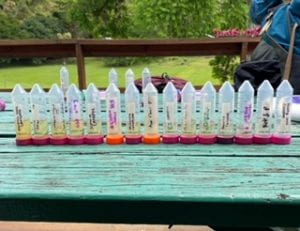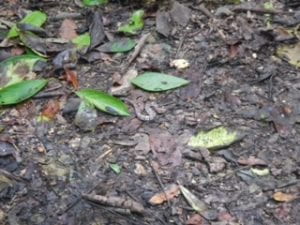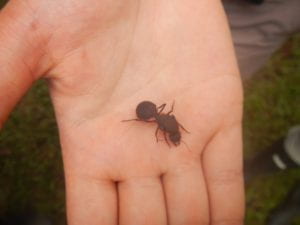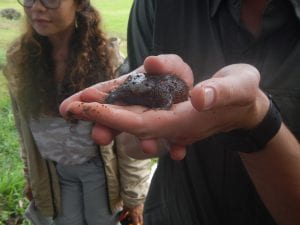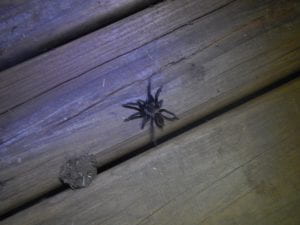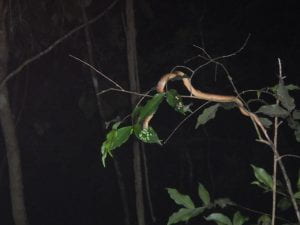May 23, 2025
Tag Archives: leafcutter ants
The Ant-Man Super Bowl: Leafcutter Nest Excavation
Day 4 (LCRS Day 2): Pee, Cecropia Trees, and even more ants!
In the afternoon, when looking for a cecropia tree, we naturally ran into the cecropia ant inhabitants. Our afternoon experiment will test whether or not young (not colonized by ants) cecropia trees will develop alternate (chemical, physical) defenses to herbivorous predators before they are colonized by ants and benefit from that defense. When we happened upon an adult cecropia tree, we got to see how they swarm out when it falls, and how the tree has evolved a hollow structure inside of it for the ants to live. The structure is an akin to the ants having high-rise apartments, because that tree is tall! Cecropia ants all fall under the Azteca family, and I think we saw Azteca alfari based on the looks. After we saw the big cecropia tree & colony, we set out to find the young uncolonized tree. While we searched, we happened upon two more really cool ant phenomena. The first, we saw a young leafcutter ant colony. We could tell it was young for two reasons: a) the colony entrances were small. there were multiple, indicating an age greater than one year, but still relatively small and therefore young. b) the ants were bicolored (red head and abdomen and a darker thorax.) Dr. Solomon did some inconclusive research as to why leafcutter ants may be discolored, but he discovered that ants were bicolored when the colony was young, which is how I know that colony is young! After the young colony, we saw an ant I hadn’t seen yet or even researched: theCamponotus sericeiventris, or Carpenter ant (but it directly translates to “Golden butt” ant, which is more fitting.) After we saw these two ants, we found the young cecropia tree, which was supposed to be uncolonized, but the one we found had one singular inhabitant: the queen! It was super cool to see her working in the little tree before her colony and her tree grew (her colony and tree did not grow because we cut it down unfortunately.) Overall, it was another fun and interesting day to be the ant man, and I know tomorrow will be even better as we are to spend the afternoon investigating leafcutter ant colonies! What a treat!
LCRS Full Day 1 and First Big Project! (And, as always, ants!)
Final Reflection Blog: An Unbelizeable Adventure!
Throughout this course I have learned and experienced so much in such a short amount of time, and I have definitely walked away with an unshakeable sense of wonder and respect for these two tropical ecosystems. One of the main ideas this course has left me with is in the surprising amount of similarities between these two seemingly separate ecosystems, and how that might relate to their current biodiversity. Both coral reefs and rainforests are shaped by their how they maximize the use of limited resources such as light, nutrients, wave energy, and soil. The variety of complex ways in which these organisms adapt to these conditions is reflected in their unmatched biodiversity.
Some personal connections I made along the way are definitely related to what I studied for my topic lecture: the biogeographic history of the region. Both of the specific ecosystems we visited were highly shaped by the history of geologic processes in the region. Glover’s atoll was created by past volcanic activity, and the limestone sediments that characterize the karstic landscape of the Chiquibul were deposited millions of years ago. Actually, the origin of the calcium carbonate in this limestone is from the many millions of marine shelled creatures that lived there when that area was underwater, so the connections run even deeper! Both areas were also deeply impacted by continental movements, specifically the connection of North and South America 3 million years ago, which separated the oceans and joined the terrestrial organisms, but still both leading to continued diversification.
This course was more difficult in some ways than I expected, but also so much fun! I definitely expected to get lots of bug bites while there, but I certainly did not expect the sheer volume of mosquito, sand mite, and chigger bites I came home with! My least favorite part was probably getting seasick on the first boat ride in, that was pretty miserable. Future TFBs beware, and bring itch cream and Dramamine! But as is true with most field work, there were so many fun moments that made all the uncomfortable parts so so worth it! Some of my many favorite moments include: seeing giant ceiba trees, watching a jaguar feed, eating lionfish ceviche, holding a comb jelly, touring the Caracol Archeological Reserve, and seeing the beloved Mexican burrowing toad! And all of these moments were made even better by the friendships I made with my classmates, which I am very grateful for.
Before I post this final blog, I want to leave it by sharing some of the most important or surprising things I learned on this trip that will stick with me for a long time. The entire guest lecture by Dr. Arevalo was definitely memorable for me, especially in his dedication to the ecology and conservation of the scarlet macaw, and his point that there is only limited impact for ecology research if we do not actively apply it to conservation practices and efforts. I will also always remember our conversations on the health of coral reefs, and how quickly climate change can damage these beautiful places. It was something I was always aware of in the periphery of my mind, but there is something different about firsthand experiencing the incredible diversity of these reefs and then learning how threatened they really are. One final thing I will always remember is seeing and learning about the insane complexity of leafcutter ant colonies! We learned that the characteristics of the ants change as the colony ages and can spread into massive structures that last with a single queen for a max of about 25 years! The fact that such complex eusocial animals have evolved is so insanely cool!
This class and the people I got to know along the way are unforgettable and I had such a great time!
-Phoenix
Pee Experiment, Leafcutter Ant Excavation, and Night Hike!
After hearing a lovely morning lecture from Michael on the importance of tropical soils and their nutrients, we designed a classic TFB experiment: pee tubes. We wanted to see whether arthropods in the canopy or the forest floor are more attracted to the nitrogen in our urine and what that might say about the scarcity of nutrients in these areas. We all peed in tubes, compared hydration levels for fun, and then set out to lay these pitfall traps in the forest. During this I actually spotted a jumping viper on the trail right before we were about to step on it which was a little terrifying, but it never struck. Someone also spotted the adorable and rare eyelash viper curled up on a tree!

After that adventure we had our very own leafcutter ant expert Dr. Solomon show us the inner workings of these colonies (including their fungal gardens!), which was so fascinating to see! During our search for a suitable candidate, we found so many arachnids! Dr. Correa found a bunch of tiny scorpions under a damp piece of wood, as well as a dead tarantula. We were also able to spot two golden silk orb weaver spiders in their web which was really cool! But the star of the show was definitely the Mexican burrowing toad we found while digging around! He was just such a fun looking guy he was so gelatinous, had no neck, and the most powerful little back legs. He was fantastic.


Then to top off a fantastic day we had an eventful night hike that definitely broke some TFB records! We took a short journey to a pond nearby and along the way saw TWO Morelet’s Tree Frog (which are a rare endangered species) both of which jumped onto some students and hung out there while we tried to photograph it which was so cool! We had to be very careful not to let it touch us if we had sprayed bug spray because they can take in chemicals through their skin, but they were so friendly! And then we saw the insane, documentary worthy event of a snake winding up a tree and eating sticky tree frog eggs! There were snakes everywhere today. It was so insanely cool! I wonder how many more cool species we can find!
Forest Cano-pee & Meeting the Queen!
Day 2 in the rainforest started off early with a lot of sightings during the morning birdwatch. I saw two crimson-collared tanagers, which are black with a red head and rump, as well as a black mask. I also say a blue-gray tanager, which is a bit smaller and flies by sporadically flitting its wings. One bird that I had to research in my field guide to identify was a white-collared seedeater! This bird was small (like the size of a finch), had a black head, light-colored wingbar(s), brown/white patchy body, and a white band laterally around its throat. I spotted it in the grass, which makes sense if it was foraging for seeds. I also saw a pale-billed woodpecker, which is a very large woodpecker with a black body, bright red head, and a white line down both sides of its neck that meets on its back. One bird that I managed to get a photo of was a social flycatcher! It was brown with a yellow breast and belly. Its white head had a black eyeline and crown, and its wings had a light wingbar.
Then, we started another experiment testing the nutrient attraction of arthropods and their abundance on the forest ground versus the forest canopy. We chose methodology to place pitfall traps of both water and a nutrient solution to test our question. The nutrient solution that was the most widely available was our own urine, so we all peed in tubes. We ranked our pee in hydration by comparing color. A huge shoutout to Rusty for having crystal clear pee and being my TFB hydration idol. Then, we put our water and pee tubes on the floor and hung them on trees!
Right by my pitfall tree, we spotted a jumping pit viper! Luckily, Phoenix saw it before anyone got too close, so we were all safe.
We also saw an eyelash viper curled on a nearby log! Rafael, the LCRS station manager, said that he had never seen an eyelash viper in all his 12 years here, so we were super lucky to see one! I didn’t get a photo, but a lot of my classmates did.
We also did a leafcutter ant activity where we dug up their nests. We started with a 1-year-old nest, and we took turns digging with a shovel. We found the fungal gardens, and it looked like spongy, white honeycomb. After some more digging, Scott uncovered the queen! She was huge and was being protected by smaller ants, but she didn’t try to bite anyone. I got to hold her! I feel so lucky to have met the queen.
We moved onto another bigger nest, but there were too many rocks and roots to dig it up. Right when we were about to find another nest, Michael shoveled one last scoop and initiated another lucky find! Sitting in the mound was a Mexican burrowing toad! This toad is black with orange markings and very round in shape. Its head is very small and is basically missing a neck. When Rusty gave his amphibian taxon briefing last night, he said that he really wanted to find one of these toads. So another shoutout to Rusty for his toad-finding dreams coming true, I’m so happy for him!
I gave my topic lecture on neotropical plant-insect interactions, and I think it went really well!
After sunset, we went on a night hike! Before leaving, I spotted a red-rumped tarantula on the deck! It crawled out of a space between some of the wooden planks.
Then on the actual night hike, We had so many amazing sightings! We saw two Morelet’s tree frogs, as well as their eggs. It is extremely rare to spot Morelet’s tree frogs because they are critically endangered, so we were really lucky to see them! Then we spotted small snakes on the tree branches above us. We witnessed one snake eat tree frog eggs!
The theme of today seemed to be pure luck, and I feel so fortunate to have experienced it all. Maybe tomorrow Ava will catch a blue morpho butterfly!
– McKenna
No time for Reef-flection, too much to T-E-Cee
This morning after breakfast, we had to say goodbye to Glover’s Reef (and Ruth). I had really started to get comfortable at Glover’s. The food, the views, the reefs, the hermit crabs and blue land crabs, the pelicans and frigate birds, iguanas, the snorkel shed, poster sessions, Clivus, and even the mosquito mangroves of death…. I’m grateful for it all.
After a 3.5 hour boat ride, we (quite fittingly) made our transition from ‘surf’ to ‘turf’ by dining on the shore at Calypso, a restaurant on the marina. After lunch, we all piled into two white vans and hit the road for the Tropical Education Center (TEC). On the drive, we passed a couple Police Security Checkpoints and got to see the dominant landscape features shift between developed cities, thick twisting mangroves, karstic mountains, and savannah peppered with palmettos.
At TEC, we received a lecture from Dr. Boris Arevalo, a conservation biologist who studies northern scarlet macaws. These macaws are a flagship species for several countries in Central America, so Dr. Arevalo wanted to better understand their nesting preferences on local and regional scales. The main points that I took away from his presentation was the importance of having a holistic understanding and management of BOTH breeding and foraging habitat, and that collaboration and communication are the most important tools for scientists. Some of my favorite quotes from Dr. Arevalo’s presentation:
- “Conservation is a human issue”
- “Scientists are professional beggars”
- “Conservation is a business”
After dinner at TEC, we got a night-time tour of the Belize Zoo! We saw more animals in an hour than I can recount here, but I’ll try to list as many as I can remember. We saw three types of owls (spectacled, mottled, and barn), four types of cat (puma, jaguar, ocelot, margay), coatimundis, a paca, white-lipped peccaries, a tapir (which we got to touch), a four-eyed possum, a termite nest, an anteater, and most importantly…. I finally saw leafcutter ants (Atta cephalotes)! My excitement at simply seeing their little nocturnal parades across the paths bodes well for this trip. I’ll probably fully lose my mind when I get to see their fungus gardens.
Day 1: Ant Man? Not quite!
Today’s general agenda: airport —> lunch at Cheers —> grocery shopping at New Flags —> Crystal Paradise Ecolodge
We have only been in Belize for less than 24 hours, but it definitely feels like we have experienced so much of it already. What may have been long car rides between destinations actually turned into interesting observations and discussions.
For instance, we spotted the Taiwan ICDF and Taiwan flags! After getting more stable internet, I quickly searched up Taiwan ICDF, and, turns out, they work towards boosting socio-economic status and providing human resources for developing partner communities. I think I was definitely surprised to see Taiwan conducting such outreach work in Belize, and I am definitely glad that they have such capacity to do so.
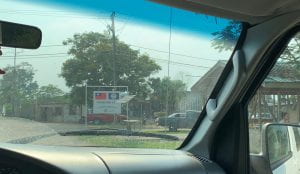
In terms of taxonomic identification (again, I am the ant-person or ant-man), I was pleased to find many different ants already! The most common ants that we spotted were leaf cutter ants, specifically Atta cephalotes. These leaf cutter ants have mandibles, which are pincer-like jaws, that cut leaves and flowers and brings them back to their nest. However, other ants identification proved to be more difficult. I spotted two ants that were roughly 1.5cm, but I could not seem to correctly identify them (see image below). My guesses are that they are some leafcutter ant species but it definitely is hard to be sure without any type of microscope.
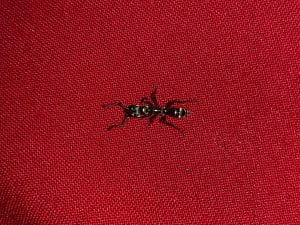
Overall, today proved to be a very eventful day! From jumping into the river to observing horses, tapirs, and more, we really have only grazed the surface of Belize. Tomorrow, we will slowly disconnect from civilization (internet is really not the best in the forest as you can imagine) and head into the deep rainforest. Until then, hopefully I’ll get better at identifying ants and I can’t wait to hear what other students have prepared for the trip.
Ant Day
Today we focused on some of the many ant species that habitate the Chiquibul forest. The cecropia tree has a symbiosis with azteca ants, which protect the tree from predators in exchange for shelter and food. We spent the morning testing a few hypothesis about how the cecropia trees avoid herbivores before they are colonized by the protector ants.
This afternoon we excavated three leaf cutter ant colonies of different maturities. Once a queen colonizes a nest after a nuptial flight she can live for 20 years reproducing, expanding the colony until there are millions of ants at any given time. There are tunnels underground leading to chambers full of the ant’s fungus garden and pupae. The youngest ones are fairly small, but once they are 10 years old they get huge, with tunnels the width of your arm full of soldier ants ready to come out and attack you when you disturb them. They have quite a pinch and we were all thankful for our rubber boots today.
We had an unexpected amphibian sighting once we got back to our housing; one of the bedrooms had a large frog on a bedpost. I caught it and took it outside to get a closer look and try to identify it. It hiccuped in my hand, puffing out its chest, in protest to its capture. The frog was dark green and brown, with some stripy markings around the forelegs. I couldn’t examine its back without it jumping from my hands so I didn’t get a clear look. It was about 2.5 inches long with horizontal pupils, bronze irises and toe pads. The toe pads indicate that its a treefrog and since there aren’t many in the area I would have to guess that it was another common Mexican treefrog, based on size and color. I released it into the trees after a minute or two to not cause it too much distressed and it leapt from my hands with a defiant squeak.
Sophia Streeter
5-20























